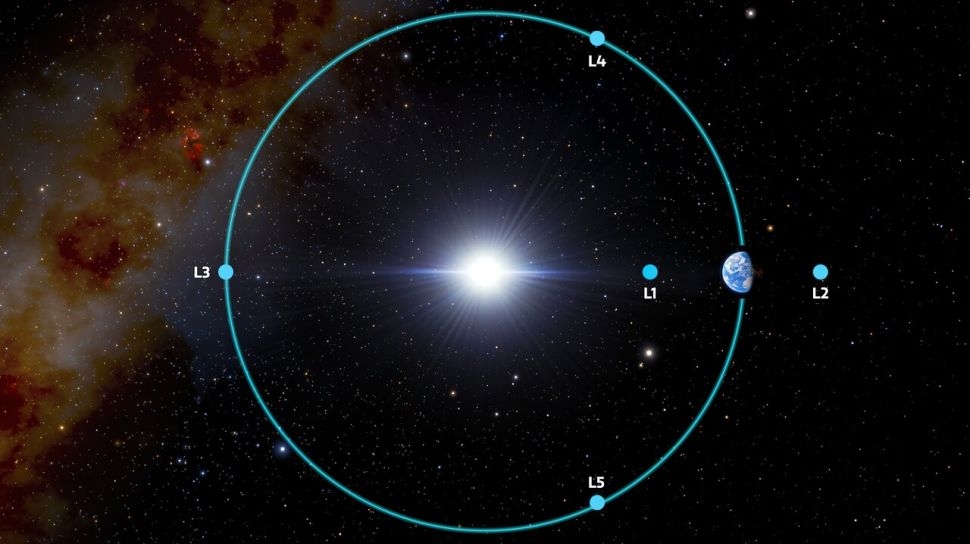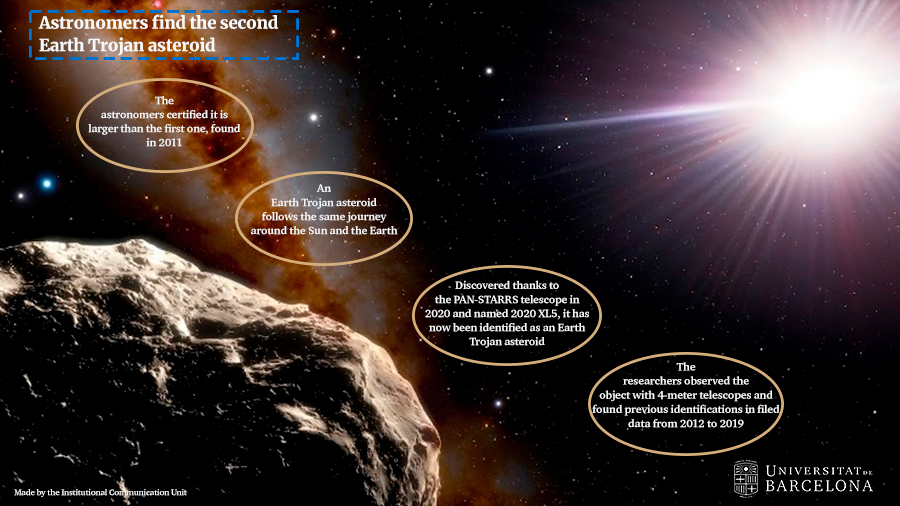Astronomers spot a companion of the Earth, and it's a Trojan !

In time for the Chinese Lunar New Year, astronomers have discovered that the Earth has another natural satellite!
It may come as a surprise to you that this is not our planet’s second “moon” – after the Moon (with a capital M) – but its third one: in October 2010, 2010TK7 was spotted for the first time. 10 years later, astronomers thought they had seen something like it again in Pan-STARRS 1 survey data, and now this has finally been confirmed.

2010 TK7 in this single frame taken by NASA's Wide-field Infrared Survey Explorer (WISE) Example of detections of 2020 XL5:
top - Pan-STARRS, bottom - Lowell DCT
2010TK7 and the new 2020 XL5 are a special kind of Small Solar System Objects (SSSOs): they are Earth Trojan asteroids. “Trojan” refers to a celestial body that orbits the Sun in a shared orbit with a planet. Newton’s laws of gravity predict that there are 5 points of equilibrium in the case of a small-mass object being gravitationally influenced by two massive orbiting bodies - all the forces that act upon an object located at that point cancel each other out. If this rings a bell, that’s because these 5 points are known as Lagrange points and yes, I will mention it here again: the James Webb Space Telescope has been placed at L2, where it has an “easy” orbit.

Looking at our trojans though, they are specifically found 60° ahead of or behind their planet at L4 or L5; confusingly, despite its name 2020 XL5 is at L4. The team of researchers that confirmed the detection, led by Dr Santana-Ros at the Institute of Cosmos Sciences of the University of Barcelona, was able to establish that this Earth Trojan has a diameter of 1.2 km, three times larger than its predecessor, and that it’s most likely a C-type asteroid, with a high carbon-content and dark colour. What’s more, 2020 XL5 is classified as a transient. This is because the researchers’ modelling suggests that in 4000 years or so, the orbit will become unstable after repeated encounters with Venus.

Until then, space agencies are considering visiting such small neighbours, not only to understand the dynamics and other properties of Trojans but also as potential sources of resources, since they may be cheaper to reach than the Moon (let alone more distant asteroids).
The problem, actually, is more on the side of spotting these asteroids. Trojans are observable when they are close to the Sun, leading to a very short observation window between the object rising above the horizon and sunrise. In fact, space telescopes had unsuccessfully tryed to spot something in the vicinity of L4 and L5 with the OSIRIS-Rex spacecraft and the JAXA Hayabusa-2 mission, respectively. What the researchers actually ended up using was the 4.1-metre SOAR (Southern Astrophysical Research) Telescope in Chile along with the 4.3m Lowell Discovery Telescope in Arizona and the smaller European Space Agency's Optical Ground Station in Tenerife in the Canary Islands, which could all be pushed to their lowest elevation limit to attempt to detect the asteroid during the time window.

SOAR 
Lowell DCT
There have also been a few cases of “short-term moons” orbiting Earth: while only 2006RH120 and 2020CD3 have been confirmed, it is likely that over the course of the Solar System’s history many more small bodies like them have temporarily followed Earth.
Likewise, there are objects (typically near-Earth asteroids) that may count as its quasi-satellites, since it does take them the same time to orbit the Sun as it does the Earth; however, this orbit is much more elliptical and escapes the Earth’s zone of gravitational influence (its Hill Sphere). Astronomers have recorded five such companions for our planet.
Trojan satellites, temporary moons, quasi-satellites ... Many things are accompanying the Earth on its journey around the Sun!
Cover Image: Artist’s concept of Earth-Trojan asteroids at Lagrange Point 4 (L4), NASA
Image Credits:
1 - A Glimmer in the Eye of WISE, NASA/Jet Propulsion Lab-Caltech/UCLA
2 - Fig. 5 from Santana-Ros, 2022 (Nature)
3 - Lagrange points, NOIRLab/NSF/AURA/J. da Silva
4 - Second Earth Trojan, NOIRLab/NSF/AURA/J. da Silva/Spaceengine / ICS/University of Barcelona
5 - SOAR, CTIO/NOIRLab/NSF/AURA
6 - Lowell DCT, Lowell Obs./NSF
